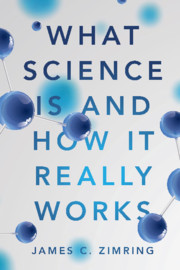Book contents
- What Science Is and How It Really Works
- What Science Is and How It Really Works
- Copyright page
- Dedication
- Contents
- Acknowledgments
- Introduction
- Part I
- Part II
- 4 How Scientific Reasoning Differs from Other Reasoning
- 5 Natural Properties of a Rule-Governed World, or Why Scientists Study Certain Types of Things and Not Others
- 6 How Human Observation of the Natural World Can Differ from What the World Really Is
- 7 Detection of Patterns and Associations, or How Human Perceptions and Reasoning Complicate Understanding of Real-World Information
- 8 The Association of Ideas and Causes, or How Science Figures Out What Causes What
- Part III
- About the Author
- Index
5 - Natural Properties of a Rule-Governed World, or Why Scientists Study Certain Types of Things and Not Others
from Part II
Published online by Cambridge University Press: 04 July 2019
- What Science Is and How It Really Works
- What Science Is and How It Really Works
- Copyright page
- Dedication
- Contents
- Acknowledgments
- Introduction
- Part I
- Part II
- 4 How Scientific Reasoning Differs from Other Reasoning
- 5 Natural Properties of a Rule-Governed World, or Why Scientists Study Certain Types of Things and Not Others
- 6 How Human Observation of the Natural World Can Differ from What the World Really Is
- 7 Detection of Patterns and Associations, or How Human Perceptions and Reasoning Complicate Understanding of Real-World Information
- 8 The Association of Ideas and Causes, or How Science Figures Out What Causes What
- Part III
- About the Author
- Index
Summary
While hypothetico-deductive (HD) coherence is required for science to be performed, it is the observable predictions of the theories that most scientists investigate; in other words, the phenomena of the natural world. Science depends upon natural phenomena as the final metric of validity. Humans are persuaded by all manner of things, many of which are emotional or authoritative in nature, and in some ways the actual practice of science is no different. However, in an ideal scientific world – the world that scientific practice strives for – the final word on “truth” is not authority, revelation, or statements of a definitive text; rather, ongoing observation of the natural world around us is the determinant of how we evaluate specific scientific facts and theories.1 Most people recognize that scientists perform studies and experiments, which are essentially a way to “check in” with the natural world – to determine whether a theory’s prediction is what actually occurs. The importance of this process of checking in – of using the natural world and natural phenomena as the ultimate arbiter of legitimate knowledge claims – cannot be overestimated. Creative thinking, to be sure, is a large part of the process that leads to scientific progress. Without great creativity, novel hypotheses cannot be retroduced, innovative auxiliary hypotheses cannot be generated, and new technologies to test predictions cannot be invented; however, creative thinking and imagination are not the “scientific” part of the process. Rather, the scientific application of innovative and creative thinking is found in the abilities of new ideas or explanations to resolve current violations of HD coherence where predictions and observations are misaligned, or to give rise to new predictions of the natural world, which can then only be tested by observation or experimentation.
- Type
- Chapter
- Information
- What Science Is and How It Really Works , pp. 130 - 154Publisher: Cambridge University PressPrint publication year: 2019



